Expressing love through food
By: Nikita Singh
On Purim, we look forward to delicate hamantaschen triangles filled with sweet mohn and fruity jams. On Rosh Hashanah, we weave big round challahs with a sweet golden glaze. Jewish holidays are always accompanied by the most flavourful and delicious dishes, like slow-cooked tsimmes, big bowls of chicken soup, and platters of smoked salmon.
Food is like a cultural calendar in Jewish life. If you’ve got latkes on your plate, you know that it’s Chanukah. If you’re eating hamantaschen, you know that it’s Purim. But, food does more than alerting us to the present, it anchors us in tradition. Food compels us to explore and revive memory.
Johannesburg-based writer and editor Daniel Browde is no stranger to revisiting memory. He spent six years excavating memory to chronicle the life of his paternal grandfather, Jules Browde. The book, The Relatively Public Life of Jules Browde, is interspersed with personal stories and recollections, some of which feature his maternal grandmother, Joy Sanders.
Daniel fondly remembers his late grandmother Joy’s festive delicacies. “On holidays like Rosh Hashanah or Pesach, she would make these huge Consol jars full of the different kinds of herring,” says Daniel, “they were fantastic, this was as good as it gets.”
On Friday nights, Joy’s specialities were leg of lamb with crispy roast potatoes or fried sole with creamy mashed potatoes and peas. “The roast potatoes were out of this world – they were really crispy on the outside and soft on the inside,” says Daniel.
Like many Jewish grandmothers, Joy expressed her love and care through food. “So many of my earliest memories of my grandmother are connected to food,” says Daniel. From the age of 3, Daniel would spend his days at his grandmother’s house in Newlands.
“Influenced by her, I used to bake a lot as a kid. I was always baking cakes, I was making biscuits,” he reminisces. “I learned from her how to make fudge.”
This process of culinary heritage passed down through generations is unique to the community because food plays such a symbolic role in our history. For example, eating apples with honey on Rosh Hashanah or eating matzah and maror at the Seder; in all of these customs and mitzvos, food plays a sensory role in storytelling and acknowledging the past.
Joy, affectionately called Ma, was an exceptional baker. “She made the best gingerbread biscuits I’ve ever had,” says Daniel. “When I think back on my late gran, I’m really struck by how talented and truly creative she was. She had skills like flower arranging, baking, knitting…sophisticated stuff. I’ve still got jerseys that she made. Those are fantastically complicated skills. I grew up not appreciating that.”
In today’s fast-paced world, it’s easy to take the little things for granted. We often put things off or dismiss something because it doesn’t seem important. Don’t wait for the big holidays and birthdays to honour the special people in your life. Take a moment to appreciate and treasure the efforts of those around you. Those homemade bulkas from your cousin, or that big jar of pickled herring from Bobba are all expressions of love, compassion, and gratitude. They are a symbol of our community’s culinary fortitude.
While Joy’s gingerbread biscuit recipe will remain a mystery; these homemade biscuits come pretty close. With fresh ginger, a crisp outside and soft inside, this parev version of a classic gingerbread biscuit is the perfect spiced afternoon treat.
Ginger Biscuits (parev)
Makes 18 biscuits
Ingredients:
½ cup canola oil
¼ cup castor sugar
¼ cup maple syrup (or maple-flavoured syrup)
2 tsp fresh ginger, minced
½ tsp ground cinnamon
¼ tsp ground nutmeg
1 egg
pinch of salt
½ tsp baking powder
1 1/3 cup cake flour
For Rolling:
Castor sugar
Icing sugar
Method:
- Beat the oil and sugar for 2 minutes until combined.
- Add the syrup and beat for another few minutes until light and fluffy.
- Add ginger, spices, and egg, then beat until combined.
- Add salt, baking powder, and cake flour. Mix until just combined, being careful not to overmix.
- Refrigerate the dough for about an hour. You can leave it in the fridge overnight if you prefer.
- Pre-heat the oven to 180°C and line a tray with baking paper.
- Coat your hands with flour to prevent sticking then roll the dough into little balls (about 3cm in diameter, the size of a truffle).
- Roll each ball first in castor sugar and then in icing sugar until coated.
- Place the balls on a tray, leaving about 4cm between each ball. Do not push down; the biscuits will spread out on their own.
- Bake for 14-15 minutes until slightly golden and cracked.




